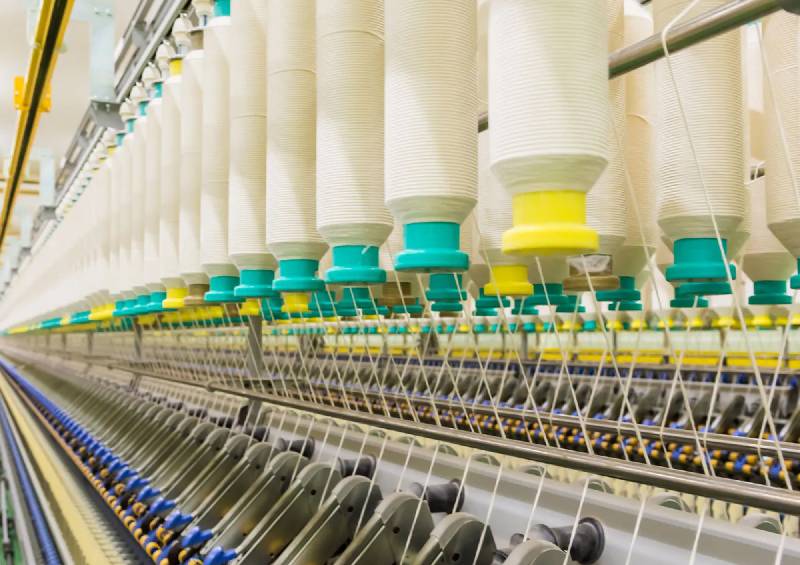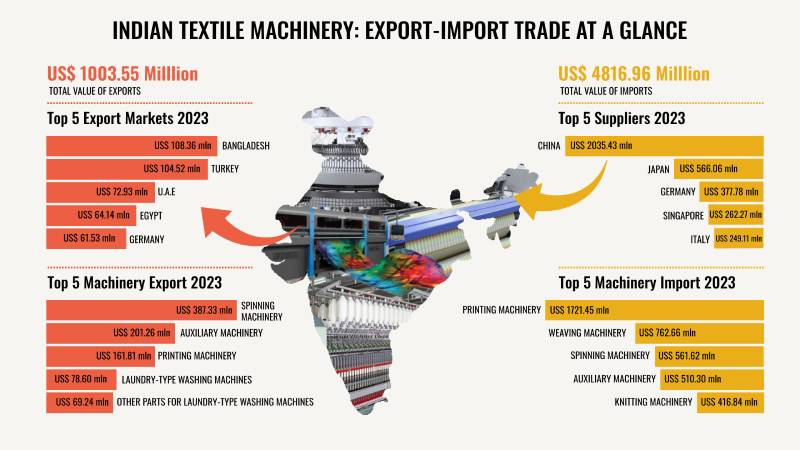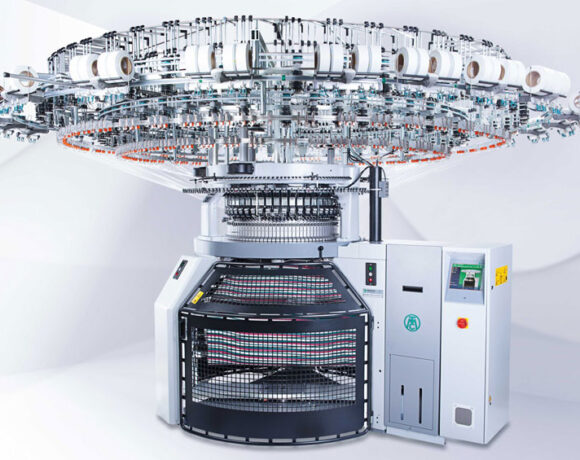From Growth To Decline: An Overview of India’s Textile Machinery Trade In 2023

In 2023, India’s textile machinery trade went through ups and downs. It was a year of change, with some parts of the segment growing, while others facing challenges. Despite this, the sector showed resilience and adaptability. Let’s take a closer look at what happened in India’s textile machinery trade last year, exploring how it coped with changes in demand, supply and market conditions.
Textile Machinery Imports Overview
India’s imports of textile machinery saw a marginal decrease of 2.20% to US$ 4816.96 million in 2023 compared to the previous year. Printing machinery, which includes imports of computer printers, emerged as the highest imported commodity with an import value of US$ 1721.45 million, marking a growth of 6.94% in 2023. This commodity represents a 36% share of India’s total textile machinery imports. Following printing machinery, weaving machines lead with a 16% share of the total.
India primarily imports its textile machinery from China, Japan, Germany, Singapore, and Italy.
Product-wise Imports Trends
Printing machinery stands out as the highest imported commodity in India’s textile machinery sector. In 2023, imports totaled US$ 1721.45 million, marking a growth of 6.94% over the previous year. Machines capable of performing multiple printing functions top the list, with imports totaling US$ 494.71 million, showing a marginal drop of 0.7% in 2023. Inkjet printing machinery imports grew by 15.55% to US$ 74.11 million in 2023. China remains the top supplier for this commodity, with imports totaling US$ 568.41 million, marking an 8.69% growth in 2023 and representing 33% of India’s total printing machinery imports. Singapore and Japan, the other top two suppliers, experienced drops of 2.8% and 15.6%, respectively.
In 2023, imports of weaving machines increased by 12.52% to US$ 762.66 million. China remains the largest supplier to India, providing machinery worth US$ 379.29 million, with a minor drop of 0.4% over the previous year. Fifty percent of India’s weaving machinery imports come from China. Imports from Japan increased substantially by 48.77% to US$ 186.83 million in 2023. Belgium also saw a significant increase, with imports from the country growing by 38.18% to US$ 106.87 million. Among the top five weaving machinery suppliers, Italy was the only country to experience negative growth, with imports falling by 7.43% to US$ 42.18 million in 2023.
India’s imports of spinning, twisting and yarn preparation machines grew by 14.6% to US$ 561.62 million in 2023. This commodity is the third-largest imported in the country’s textile machinery sector. Textile winding machines are the most imported, with imports totaling US$ 291.90 million, witnessing a growth of almost 40% in 2023. Cotton yarn winding machines alone were imported worth US$ 187.98 million, showing a growth of 29.28% in 2023. Japan is the largest supplier of this commodity to India, with imports totaling US$ 170.47 million, marking a growth of 51.9% in 2023 and representing 30% of the total spinning, twisting and yarn preparation machine imports. Imports from China dropped by 9.7% to US$ 133.67 million. There was a significant rise in imports from Italy, the Netherlands and Belgium, with growth rates of 63.03%, 26.29% and 87.66%, respectively, in 2023.

Knitting machines rank as the fifth-largest commodity in India’s textile machinery imports. The imports totaled US$ 416.84 million, experiencing a negative growth of 2.06% in 2023. Machines for making embroidery, under this commodity segment, totaled US$ 234.08 million, growing by 8.6% in 2023. The majority of knitting machine imports to India came from China, totaling US$ 299.07 million, with a growth of 1.64% in 2023. China accounts for a 72% share of India’s total knitting machine imports. There was a substantial growth of 118.41% in imports from Japan to US$ 26.12 million and from Belgium by 272.33% to US$ 20.11 million in 2023.
In 2023, auxiliary machinery imports dropped by 15.6% to US$ 510.30 million, representing 11% of India’s total textile machinery imports. China is the leading supplier for this commodity, but imports dropped by 28.6% to US$ 195.20 million in 2023. Currently, China holds a 38% share of India’s total auxiliary machinery imports. Germany, the second leader, experienced growth of 20.67% to US$ 144.49 million in 2023. Japan, Switzerland and Italy, among the top five suppliers of auxiliary machinery for India, all experienced negative growth of 21.09%, 8.61%, and 14.3%, respectively.
Nonwoven machine imports to India drastically dropped in 2023 by 66.54% to US$ 43.27 million compared to the previous year. Here too, China is the top supplier to India, but imports from China dropped by 46.22% to US$ 29.11 million. Other top suppliers, such as Germany and Italy, also experienced negative growth of 87.89% and 27.09%, respectively, in 2023.
Imports of extruding, drawing and texturing machines totaled US$ 126.15 million, marking a drop of 12.58% in 2023 compared to the previous year. Again, China is the top supplier for this commodity, with imports totaling US$ 94.38 million, showing a growth of 53.04%.
Imports of sewing machines witnessed a drop of 25.24% to US$ 267.82 million in 2023 compared to the previous year. Once more, China is the top supplier to India, with imports totaling US$ 158.09 million, experiencing a negative growth of 23.84% in 2023. Singapore and Vietnam, the other top two suppliers to India, both experienced negative growth of 38.72% and 1.08%, respectively, in 2023.
Country-wise Textile Machinery Imports to India
China remains the top supplier to India for textile machinery. India’s textile machinery imports from China totaled US$ 2035.43 million, but imports dropped by 5.67% in 2023 compared to the previous year. China holds a 42% share of India’s total textile machinery imports.
Japan is the second-largest supplier to India, with imports totaling US$ 566.06 million, showing a growth of 22.17% in 2023 compared to the previous year. Japan holds 12% of the total imports of India’s textile machinery.
Germany is the third-largest supplier of textile machines to India, with imports totaling US$ 377.78 million in 2023, but experiencing a negative growth of 6.94%. Printing machines saw a sudden rise in imports with a growth of 120.44% to US$ 82.25 million in 2023, while nonwoven machine imports dropped by 87.89% to US$ 7.16 million over the previous year.
Singapore, the fourth-largest supplier to India, registered negative growth of 9.61% in 2023, totaling US$ 262.27 million. Italy, the fifth-largest supplier, experienced a growth of 6.60% to US$ 249.11 million in 2023. Belgium is the leading supplier for weaving machines, with imports totaling US$ 106.87 million, a growth of 38.18%.
Textile Machinery Exports Overview
India’s textile machinery exports declined by 5.09% to US$ 1003.55 million in 2023 compared to the previous year. Under the export segment, spinning, twisting and yarn preparation machines were exported the most to the world. This commodity makes up 39% share of the total textile machinery exports from India. Bangladesh remains the largest market for India’s textile machinery products.
Product-wise Export Trends
Spinning, twisting and yarn preparation machines are the largest exported commodity, with a value of US$ 387.33 million and a negative growth of 3.07% in 2023. Turkey remains the largest market for India’s spinning, twisting and yarn preparation machines. Exports to Turkey totaled US$ 78.85 million, experiencing a decline of 23.46% in 2023. Bangladesh, the second-largest market, also witnessed a negative growth of 24.33% to US$ 67.51 million in 2023.
Auxiliary machines witnessed a downtrend, with a negative growth of 13.75% to US$ 201.26 in 2023. China was the leading market for India’s auxiliary machines in 2022, but last year, exports dropped by 55.5% to US$ 17.53 million in 2023. Germany remains the second-largest market for India’s auxiliary machines, but it witnessed a drop of 19.2% to US$ 19.70 million in 2023. With a sudden rise of 80.4% in exports to the U.A.E., it is now the leading market, totaling US$ 21.22 million.
Printing machinery exports rose slightly by 14.39% to US$ 161.81 million in 2023. Russia witnessed a growth of 535.47% to US$ 15.26 million, making Russia the leading market for India’s printing machinery. Exports to Bangladesh grew by 5.45% to US$ 13.99 million in 2023.
India’s weaving machines were low in demand in 2023, witnessing a drop of 29.3% to US$ 27.35 million over the previous year. Exports to Bangladesh for weaving machines dropped by 55.23% to US$ 2.66 million, making Bangladesh the second-largest market for this commodity.
Sewing machine exports totaled US$ 62.35 million in 2023, witnessing a marginal drop of 4.16%. Germany is the leading market for this commodity, with exports totaling US$ 17.64 million, a growth of 9.76%.
Country-wise Export Trends
In the overall textile machinery exports of India, Bangladesh remains the largest market, totaling US$ 108.36 million in 2023, but experiencing a 26.8% drop over the previous year. Bangladesh holds share of 11% of the total textile machinery exports from India. Turkey remains the second-largest market for Indian textile machines, with exports totaling US$ 104.52 million, but witnessing a drop of 20.1% in 2023.
China was the third-largest exports market for India in 2022, but with a drop in 2023, the country stood as the sixth-largest market. In 2023, exports to China totaled US$ 55.59 million, with a drop of 35.1%. The U.A.E. is the third-largest market, with exports totaling US$ 72.93 million and experiencing a growth of 21.9% in 2023.
There was a sudden spike in exports to Egypt, with exports to the country growing by 122.2% to US$ 64.14 million in 2023 over the previous year. The demand for spinning, twisting and yarn preparation machines rose by 135.1% to US$ 56.04 million in 2023, contributing to the increase in exports to the country.
(Article by Henry Dsouza, Associate Editor of Textile Insights)














